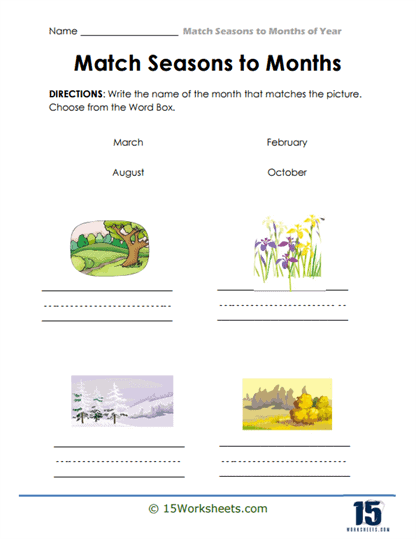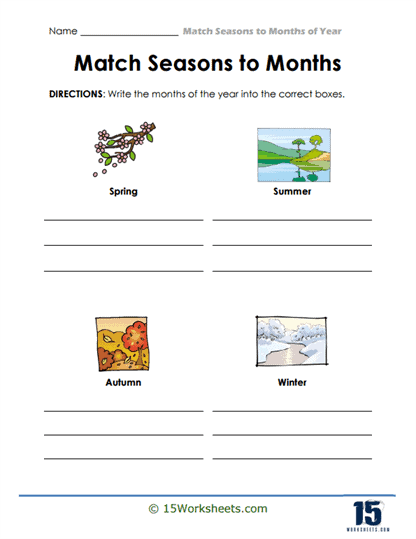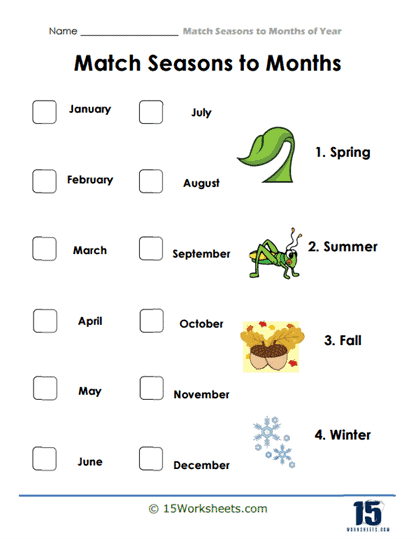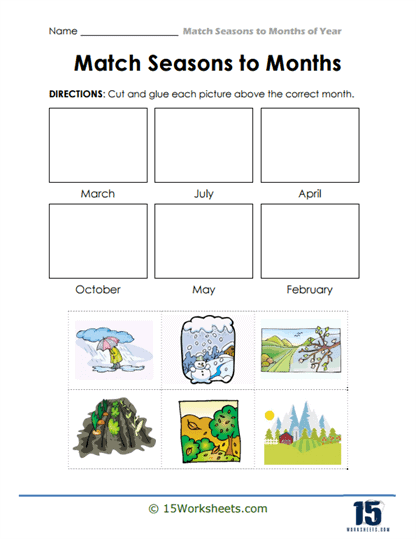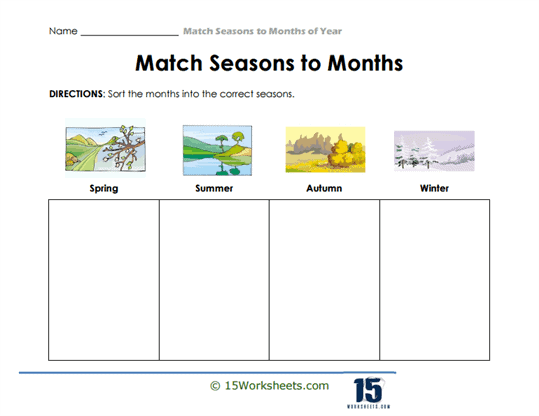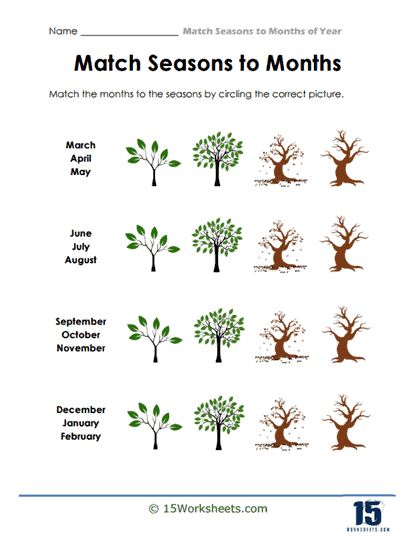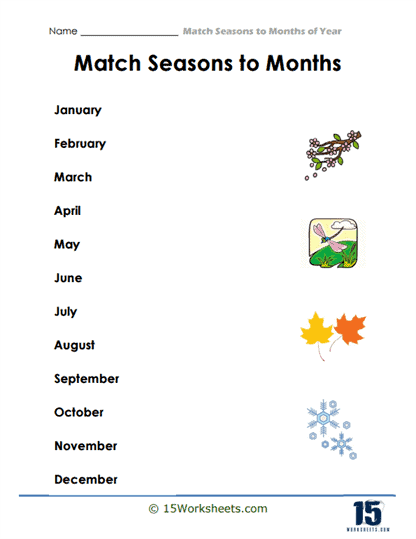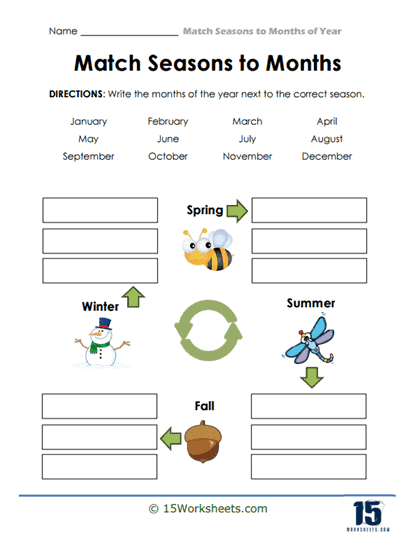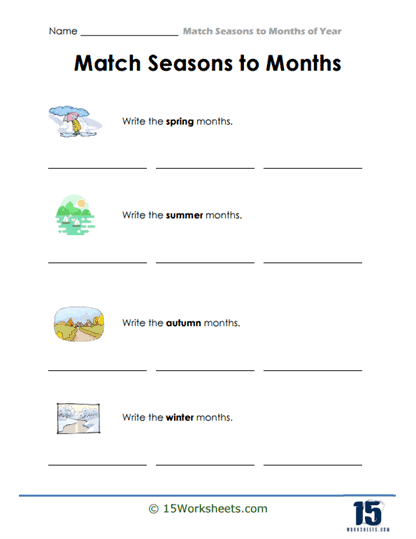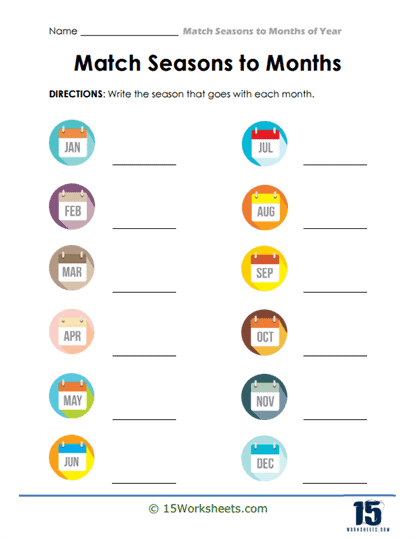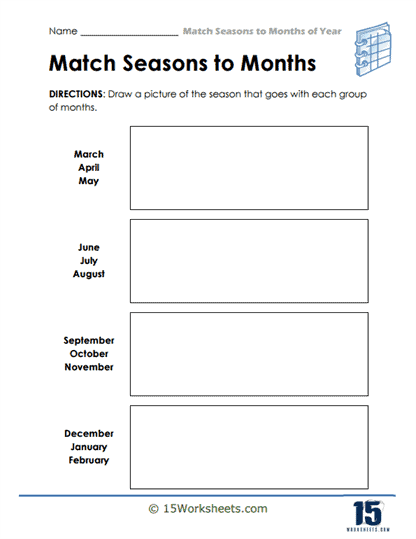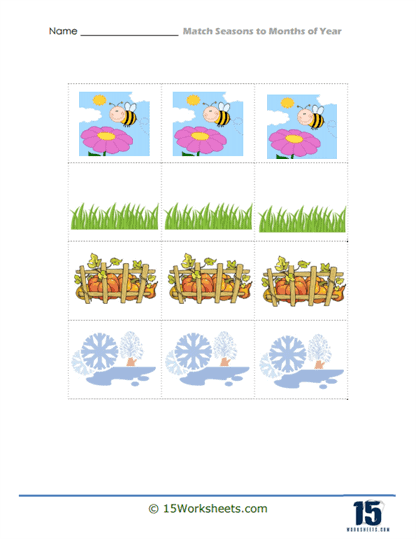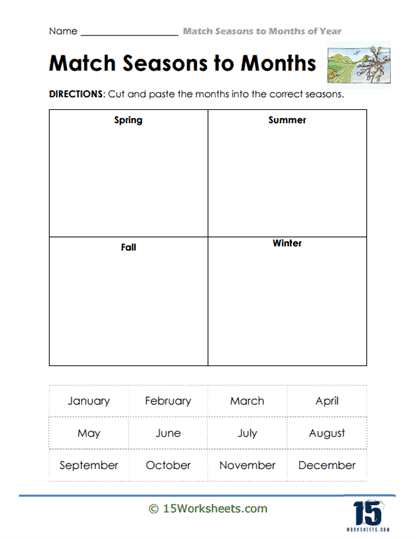Match Seasons to Months Worksheets
About These 15 Worksheets
These worksheets will enhance students’ understanding of the relationship between the months of the year and the four traditional seasons: spring, summer, autumn (or fall), and winter. These worksheets provide various exercises that enable students to correlate specific months with their corresponding seasons, deepening their grasp of the calendar and the cyclical nature of seasonal changes. Engaging with these worksheets offers several benefits in terms of cognitive development and understanding of the world.
The worksheets also contribute to their overall cognitive development, language skills, and appreciation of the natural world. These worksheets use various exercises to cater to different learning styles, making them an effective tool in your classroom.
Types of Exercises
Sorting Activities – The most common type is where students match months to their respective seasons. For example, they might draw a line connecting ‘June’ to ‘Summer’ or ‘December’ to ‘Winter’. This straightforward activity reinforces the basic knowledge of which months fall into each season. Here, students receive a list of months and are asked to sort them into four groups representing the seasons. This exercise demands a bit more critical thinking as students must remember and categorize each month without direct prompts.
Seasonal Characteristics Identification – These worksheets may ask students to identify characteristics or typical activities of each season and then link them to the appropriate months. For example, they might associate ‘building a snowman’ with winter months or ‘going swimming’ with summer. Some worksheets include sections where students draw or color scenes depicting the seasons, labeling the months in which those scenes would typically occur. This blends artistic expression with educational content, making the learning process more engaging.
Seasonal Change Sequencing – These exercises might present a series of pictures or statements describing seasonal changes (e.g., leaves falling, flowers blooming) and ask students to sequence them according to the months they occur. More advanced worksheets might prompt students to write short narratives or journal entries about activities or events they associate with different months, encouraging them to connect personal experiences with their understanding of seasons.
The Benefits of These Worksheets
Enhanced Calendar Literacy
Regular engagement with “Match Seasons to Months Worksheets” significantly bolsters a student’s familiarity with the calendar. This familiarity extends beyond merely identifying and naming the months; it encompasses a comprehensive understanding of their sequential order. Such knowledge is instrumental in various aspects of daily life and academic learning. It aids in planning and scheduling, essential skills in both personal and educational contexts. Furthermore, it lays the foundation for grasping time-related concepts, which are pivotal in subjects like history and social studies, where timelines and chronological understanding are key.
Understanding of Seasonal Cycles
The practice of linking months to specific seasons fosters a deeper appreciation for the cyclical nature of the year. This understanding transcends the basic knowledge of seasonal names; it connects students to the larger patterns that govern the natural world. In science education, this comprehension is particularly crucial. Students begin to see the tangible connections between seasons and various natural phenomena, such as weather patterns, the life cycles of plants, and the seasonal behaviors of animals. This holistic view is essential for developing a nuanced understanding of ecology and environmental science.
Development of Cognitive Skills
The activities in these worksheets are not just rote memorization tasks; they actively engage several cognitive skills. Memory recall is exercised when students remember which months fall into which season. Pattern recognition is developed as they start to see the recurring themes and characteristics of each season. Logical thinking is honed through exercises that require sorting, matching, and sequencing months with seasons. These cognitive skills are not confined to the realm of understanding seasons; they are transferrable skills that enhance learning and problem-solving abilities across various academic disciplines.
Connection to the Natural World
An in-depth understanding of seasons bridges the gap between academic knowledge and the natural world around us. Students learn the reasons behind seasonal changes, such as why leaves fall in autumn or why flowers bloom in spring. This not only enriches their academic knowledge but also fosters a deeper appreciation and respect for nature and environmental changes. It encourages an awareness of the world they live in, nurturing a sense of responsibility towards the environment and an understanding of their role within the natural ecosystem.
Enhancement of Vocabulary and Language Skills
Working through these worksheets contributes significantly to the development of a student’s vocabulary and language skills. The tasks involve reading instructions, understanding seasonal vocabulary, and possibly engaging in descriptive writing or storytelling. This exposure to a varied language related to time, weather, and natural phenomena enhances both vocabulary breadth and reading comprehension. Moreover, if the worksheets include writing exercises, they can also significantly improve writing skills, allowing students to articulate their thoughts and observations effectively.
Social and Cultural Awareness
The correlation between seasons, months, and cultural events is another vital aspect of learning with these worksheets. Many cultures have festivals, traditions, and holidays that are tied to specific seasons or months. By understanding this relationship, students develop a broader cultural awareness. They learn to appreciate and respect the diversity of cultural practices and how they align with the seasonal calendar. This awareness is particularly important in our globalized world, where understanding and respecting cultural diversity is key to social harmony and mutual respect.
Encouragement of Creativity and Personal Expression
Lastly, these worksheets often include creative tasks like drawing, coloring, and storytelling. Such activities provide a platform for personal expression and creativity. Students are encouraged to depict their understanding of seasons through art, allowing them to express their perceptions and experiences of different times of the year creatively. This not only makes the learning process more enjoyable but also helps in cementing their understanding through personal engagement and expression. Such activities can be particularly effective in catering to different learning styles, ensuring that all students find an engaging and meaningful way to connect with the content.


